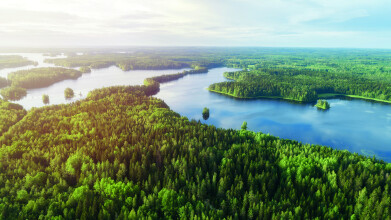Water pollution monitoring
How artifical wetlands could aid water quality in Asian waterways
Aug 23 2024
The concept of "living machines" refers to engineered ecosystems that utilise biological processes to treat wastewater, restore ecosystems, and manage water resources. These systems mimic natural ecological processes to provide sustainable and efficient solutions for environmental challenges. In the context of Asia, where rapid urbanization, industrialization, and population growth have significantly impacted water quality and ecosystem health, living machines offer a promising approach for waterway management.
Living machines are bioengineered systems that integrate a variety of organisms, such as plants, bacteria, fungi, and aquatic animals, into a controlled environment to perform specific ecological functions. These functions can include filtering and purifying water, breaking down organic matter, removing pollutants, and even generating energy. By leveraging natural processes like photosynthesis, nutrient cycling, and microbial degradation, living machines can treat wastewater, restore degraded environments, and enhance biodiversity in urban and rural settings.
Typically, living machines are designed to be modular and scalable, allowing them to be customized for different environmental conditions and purposes. They can be as small as a household wastewater treatment unit or as large as a city-wide system for managing stormwater and industrial effluents. The key advantage of living machines is their ability to adapt to changing environmental conditions while requiring minimal energy and chemical inputs, making them a sustainable alternative to conventional treatment technologies.
Asia faces significant water quality challenges due to rapid industrialization, urbanization, and agricultural intensification. Rivers, lakes, and coastal areas are often heavily polluted with industrial effluents, agricultural runoff, and untreated sewage. The impact of these pollutants on water quality is severe, leading to the degradation of aquatic ecosystems, loss of biodiversity, and threats to public health. For instance, the Ganges River in India, the Yangtze River in China, and the Mekong River which runs through Myanmar, Laos, Thailand, Cambodia, and Vietnam, are all facing critical levels of pollution that affect millions of people and countless species.
In addition to pollution, many of Asia’s waterways are also impacted by habitat loss, overfishing, and climate change. Wetlands and mangroves, which serve as natural buffers against floods and support diverse wildlife, are being destroyed at an alarming rate. As these ecosystems degrade, their ability to provide essential services, such as water filtration and carbon sequestration, diminishes. The deployment of living machines in Asia’s waterways could address these challenges by providing a sustainable means of improving water quality, restoring degraded habitats, and enhancing ecosystem services.
Living machines could be deployed in various ways across Asia to address specific water management challenges. For example, in urban areas, living machines could be integrated into wastewater treatment plants to enhance their capacity for nutrient removal and pollutant degradation. These systems could also be installed in industrial complexes to treat effluents before they are discharged into rivers, reducing the burden on downstream ecosystems.
In rural areas, living machines could be used to treat agricultural runoff, which is a major source of eutrophication in many Asian water bodies. By capturing and treating runoff before it reaches rivers and lakes, living machines could prevent the accumulation of harmful algal blooms and improve water quality for both human and ecological use.
Restoration of degraded wetlands and riverbanks is another potential application of living machines. These systems could be designed to support native plant species and enhance habitat complexity, providing refuge for wildlife and improving the resilience of ecosystems to climate change. For instance, in coastal areas, living machines could be used to restore mangrove forests, which are crucial for protecting shorelines from erosion, supporting fisheries, and sequestering carbon.
Despite their potential, the deployment of living machines in Asia faces several challenges. One of the main challenges is the need for site-specific design and maintenance. Unlike conventional treatment systems, living machines must be carefully tailored to the local environmental conditions, including climate, water chemistry, and the presence of native species. This requires significant expertise in ecological engineering and ongoing monitoring to ensure that the systems function effectively over time. Public perception and acceptance of living machines also play a crucial role in their deployment. Educating stakeholders about the benefits of living machines and demonstrating their effectiveness through pilot projects can help build trust and support for these systems.
Digital Edition
IET 35.2 March
April 2025
Air Monitoring - Probe Sampling in Hazardous Areas Under Extreme Conditions - New, Game-Changing Sensor for Methane Emissions - Blue Sky Thinking: a 50-year Retrospective on Technological Prog...
View all digital editions
Events
Salon Analyse Industrielle & Instrumentation
May 14 2025 Paris, France
May 15 2025 Istanbul, Turkey
May 18 2025 Algiers, Algeria
May 19 2025 Kansas City, MO, USA
May 19 2025 Phoenix, AZ, USA



















